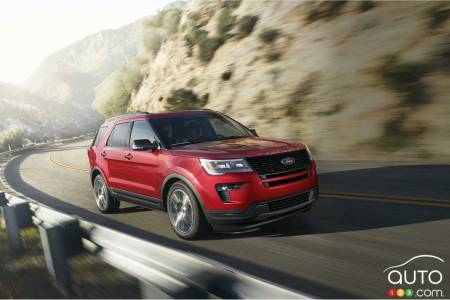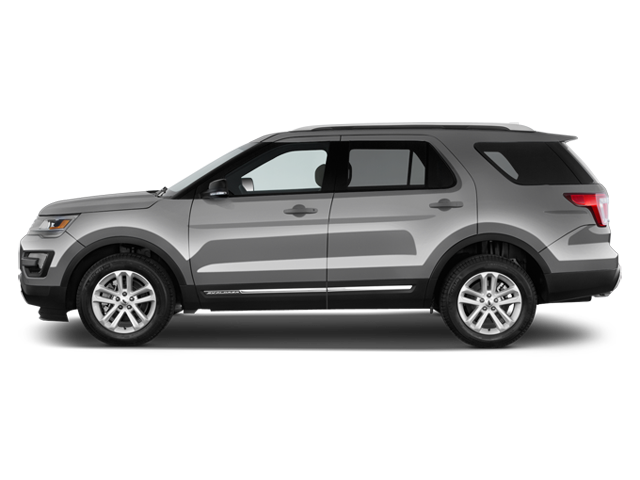It’s hard if not impossible to ignore the Ford Explorer in the Canadian landscape. You see them everywhere. It is one of the most popular mid-size SUVs on our market. But it does face stiff competition from the likes of the Jeep Grand Cherokee. Last year, Jeep managed to move over 23,000 units of that model in Canada. Ford’s Explorer? A “measly” 17,000 units sold. That is enough, though, to place it second in its category, ahead of the Dodge Durango, Nissan Pathfinder, Toyota Highlander, Honda Pilot and others.
For 2018, the Explorer that Ford presents to us is largely unchanged. Is that sufficient to keep it competitive?
The 2018 edition of the Explorer gets a few tweaks to the front grille, headlights, exhaust tubes and alloy wheels, as well as coming in some new colours. The model comes in five trims, including the base Explorer, the more elaborate XLT, the luxurious Limited, the Sport version (the one reviewed here) and the Titanium, the most luxurious version.
Rumour has it that Ford intends to also introduce an ST performance version of the Explorer in the coming months, powered by a 400+-hp turbocharged V6 (likely the 3.0L mill currently in the Lincoln MKZ and Continental). As well, Ford is said to be at work on a next-gen Explorer, possibly for 2020; that edition would rest on the new CD6 platform, and will probably come with either rear-wheel or all-wheel drive as standard equipment.
This would represent a return to its roots of sorts. You’ll recall that, when it debuted, the Explorer was a kind of stretched four-door version of the Bronco II. That first version sat on a rigid rear-wheel-drive chassis with engine power going on command to the four wheels. These days, the latest Explorers have been conceived as single-body or monoshell vehicles with front-wheel drive system by default.
For the moment, Ford is offering three engines for the new Explorer, including the base 3.5L V6 that produces 290 hp and 255 lb-ft of torque, the 2.3L 4-cylinder EcoBoost (280 hp and 310 lb-ft) and the 3.5L twin-turbo EcoBoost V6 (365 hp and 350 lb-ft). This last is the one that sits under the hood of the Sport version. The only available transmission is a 6-speed automatic, but it is possible to choose either front-wheel or all-wheel drive. (except for the 3.5L EcoBoost engine, which can only be paired with all-wheel drive). Buyers who choose this last set-up also get the Terrain Management System, which allows the driver to choose a transmission configuration that adapts the vehicle’s performance to fit the terrain being driven on, for instance mud, sand, gravel or snow.
Of course, many buyers choose the Explorer for its capacity to tow what they need towed. In the past, Ford gave a higher capacity than it now does for the model; apparently at some point the company realized that most of the consumers apt to buy the Explorer didn’t plan to ever pull more than 5,000 lbs with it. Since 2011, when the current generation debuted, this has been the official towing capacity of the model. The driver just has to push the Tow button on the dashboard, to the left of the steering wheel, to get the automatic transmission to adjust the gear changes as needed or even to slow the vehicle down.
The interior of the latest Explorer has changed little since the current generation debuted, except that the finishing is now much improved. The navigation system (part of Sync 3) and the collision warning features have been revised and upgraded. The dashboard features a fully programmable instrument cluster in front of the driver, while on the centre console sits a big screen to access the Sony audio system, navigation and the many touch commands for the climate control system, including those for the front seats. WiFi, Apple CarPlay and Android Auto can also be added to the package.
The steering wheel contains its own set of commands, but these are manual. The front seats (bucket, of course), are heated and ventilated in the Sport edition. Buyers can choose to have two or three seats in the second row, while the back row contains the requisite seating designated for children or smaller adults. That third row is fold-down (power-operated), providing an enormous cargo area, which gets downright ginormous when you also fold down the middle-row seats. To access this rear cargo extravaganza, simply swipe your foot under the rear bumper (while having the fob in your possession, naturally); the hatch opens automatically. Repeating the process closes the hatch again as well, or you can use the power button. The interior finishing of this Explorer Sport is more refined and elaborate than in the base or XLT models, though I shouldn’t overstate this, as the changes aren’t monumental. Consider it a light touch of added luxury.
At the wheel
Thanks to its platform, the same one that also underpins the company’s cars (the Ford Taurus and Flex, the now-abandoned Lincoln MKS and MKT), the Explorer actually drives kind of like a big sedan. The many-ways power-adjustable driver’s seat and steering wheel means you can fine-tune the driver’s position for maximum comfort and optimal visibility, even with that hood that sits kind of high in the field of vision. When the back seats are not occupied, it’s a good idea to push down the headrests so that they don’t block the line of sight out the back.
Once out on the road, it’s easy to take an immediate liking to the powerful EcoBoost V6 engine, the 365 hp of which are distributed to the front or back wheels by the advanced transfer case equipped with a computer to determine the best distribution of power. The automatic transmission operates smoothly, and the driver can use the paddle shifters on the steering wheel to help things along if desired.
0-100 km/h acceleration took under seven seconds with this powertrain. Passing is also impressively easy and smooth. Know that the Sport edition, when equipped with the premium audio system, reproduces a V8 engine sound delivered via the speakers. The driver has no control over this system (which is pretty discreet), but you will get the vibe of having a V8 under the hood. This sound, by the way, is not heard outside the cabin. This is called Engine Sound Enhancement or Active Noise Control, and it’s only heard when the engine is being solicited.
The Explorer is a bit clumsy for manoeuvering in urban settings and in parking situations, but it’s an ideal partner for longer road trips. Fortunately, the cameras that are there to help you when it comes time to park (some of which must be activated) are complemented by available park assist features for both parallel and perpendicular parking! It takes a little practice to master them, but once you do they’re really helpful.
Obviously not a sports vehicle, the new Explorer does, with its “car” platform, offer a driving experience superior to the older models, which drove on raised suspensions. Braking duties are handled by four powerful discs supported by ABS, while the steering is power-assisted. The 20-inch wheels are fitted with 50 series tires.
Average consumption after a week with this Ford SUV was 14.4L/100 km in a mostly urban environment (Ford’s official stats are 14.8L/100 km in city, 10.7 on highway).
In terms of pricing, the 2018 Explorer Sport starts at $54,199. Add in the multitude of options (for instance a power glass panoramic roof, screens behind the front headrests and other goodies), and the final tally for our tester was $59,829, plus the $1,790 delivery fee.
If you want to see what the model’s eventual redesign might look like, there are already images floating around online. The next edition is not due to be revealed until early 2019 as a 2020 model-year. It seems likely that the next Explorer will look quite similar in its contours to the Aviator concept we’ve seen from Lincoln, first unveiled at the latest New York auto show. Will it still be up to facing down the competition? Stay tuned…
Road Tests and Reviews








